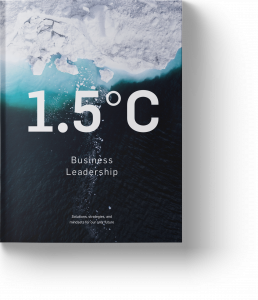By Erik Rasmussen, founder, Sustainia
The 1.5°C business leader has to rethink and expand what business is all about — and do it fast. The next 1,000 days might decide what it takes to be a transformative leader.
In 2030, when we look back 10 years we might remember this period as the biggest, strongest, and most challenging disrupter of business leadership ever with the disrupting force of climate change as a complete business game changer. If not we may have failed our climate mission and not clearly understood what 1.5°C leadership is all about. Solving climate change needs a fundamental mindset change — rethinking and expanding what it takes to do sustainable business.
Until now we have been through the easiest part of the process: creating awareness of the Sustainable Development Goals and the climate challenges by discussing the challenges and options at numerous conferences and seminars. It has paid off in the business community. According to a 2019 survey conducted by the UN Global Compact, 85% of global CEOs claim that they are personally committed to ensuring that their company is a sustainability leader.
But now follows the difficult part: turning awareness and commitments into business reality. That seems to be another ball game, according to the UN Global Compact survey. Only 32% of the CEOs indicate their company has, or plans to set, corporate goals that are sufficiently ambitious, science-based and aligned with the needs of society.
The survey also reveals that while 71% recognise the critical role that business could play in contributing to the delivery of the Sustainable Development Goals, a mere 21% believe that business is actually playing that role.
The 1,000 day transformation
These and other supporting figures confirm why true and credible 1.5°C business leadership calls for new mindsets and new business models. And speed matters. Still more reports with still more alarming conclusions confirm that we are far off the 1.5°C trajectory but are heading for critical tipping points and temperature rises of 3°C and more. So this year is really the last, last call for 1.5°C business leadership.
Given the speed and scale of the challenges, we have to downplay the 2030 deadline. Instead, we must deliver breakthrough results within a much shorter time span: three years. If business at large cannot provide major transformations within 1,000 days, we risk falling further behind and any narrative of 1.5°C business leadership will be more fiction than fact. That is why 1.5°C business leadership should entail more than committing to more ambitious targets. It should commit any company to expand its role and responsibility in developing sustainable societies.
One thing is joining the campaign and committing to setting targets. Another and far more demanding challenge is to integrate this into all business decisions and embed the corporate commitment throughout the company with buy-in from all employees. It is a matter of developing a new corporate identity. The 1.5°C campaign should be seen as a major transformer of a business model — an opportunity to rethink the raison d’être of the company in a new world order. Failing to understand and accept that perspective, the commitment risks being reduced to an instant CEO gimmick. Becoming a 1.5°C business leader should be rated as a fundamental strategic decision with widespread implications for the company.
So far more than 600 companies have committed to setting science-based targets and around 60 of those companies have committed to 1.5°C. That is good news for a start, but what really matters are the first impact reports — how did it work out and how did it change the business models and influence the climate? We need to learn these lessons very fast, and we need a breed of ‘1.5°C business heroes’ who can galvanise business leaders to join the 1.5°C campaign.
That is why ‘1.5°C business leadership’ should be seen as a prerequisite for tomorrow’s CEOs — a leadership that must expand its role and responsibility in society. Taking action for 1.5°C means recognising and accepting a new business paradigm that makes private companies entrepreneurs of a new sustainable world order. The 17 Sustainable Development Goals have defined the new role of business, which has been embraced by companies. But as documented in the UN Global Compact surveys, businesses must now translate commitments into new business models, strategies, and solutions.
It all depends on mindsets and how to approach the turbulent business environment. You must understand that the dif- ference between a risk and an opportunity is how soon you discover it, and why the difference between managing risks and opportunities is a matter of being reactive or proactive. There is no doubt about what kind of leadership is needed to remain within 1.5°C degrees.
Choose your history
Climate change tops the list of environmental, social, and governance (ESG) concerns for investors in 2019 and consumer perceptions of corporate sustainability performance are having more and more of an impact on purchasing patterns. The accelerating treadmill of corporate leadership combined with growing pressure from stakeholders means that CEOs who do not become 1.5°C leaders will simply be eliminated.
1.5°C business leaders may be considering their position in history. In 2100 we will know if we managed to stay below the 1.5°C scenario. Scientific models will have been played out, and we will have seen the consequences of climate change caused by the human race. The 1.5°C business leaders of 2019 may be those remembered as the minority who tried and failed, or the vanguard who upped their ambition and led the masses. And the CEOs who did nothing will be seen as the villains of the past. 1.5°C business leaders are choosing right now which side of history they wish to fall.
As the global average temperature continues to rise and we increasingly see the effects of climate change in reality, the time for leadership is now. Some are born for this type of leadership, but many will have to transform from just CEOs to become 1.5°C business leaders and join the private sector climate vanguard. Only those with the right mindset will be able to make this transformation, and only they stand a chance of being remembered favourably in 2100.
Facts



